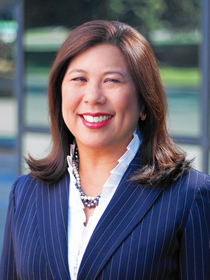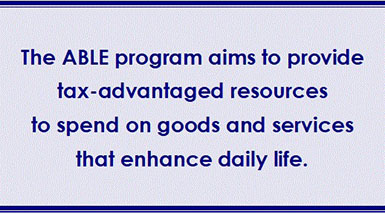You can also view this newsletter as a PDF.

CalABLE: Improving Life for Californians with Disabilities
 The federal Achieving a Better Life Experience (ABLE) Act provides an important tool for people with disabilities to achieve a greater degree of financial independence. Recognizing the special financial challenges families face over a lifetime raising children with disabilities, the federal ABLE Act of 2014 added to the Internal Revenue Code rules under which states or state agencies may establish a tax-favored savings and investment program to provide secure funding for disability-related expenses while maintaining eligibility for vital public assistance.
The federal Achieving a Better Life Experience (ABLE) Act provides an important tool for people with disabilities to achieve a greater degree of financial independence. Recognizing the special financial challenges families face over a lifetime raising children with disabilities, the federal ABLE Act of 2014 added to the Internal Revenue Code rules under which states or state agencies may establish a tax-favored savings and investment program to provide secure funding for disability-related expenses while maintaining eligibility for vital public assistance.
An individual must have less than $2,000 in countable resources to qualify for Supplemental Security Income (SSI). Up to $100,000 in an ABLE account now is excluded from consideration for means-tested federal programs, meaning a person with a disability can have up to $100,000 set aside in an ABLE account for future care needs without running into an asset-test barrier that excludes them from receiving SSI. (If an ABLE account balance were to exceed $100,000, the beneficiary’s SSI benefits would be suspended until the balance drops below the $100,000 threshold.)
In December 2018, California became the 41st state to launch an ABLE program (CalABLE), administered by the State Treasurer’s Office and overseen by a seven-member board including the State Controller. In less than a year, CalABLE enrollment has exceeded 1,600 and $5.4 million assets under management. The California program is experiencing more than 50 new enrollments each week as marketing and outreach ramps up.
CalABLE offers significant benefits to people with disabilities, both in terms of tax efficiency and improved economic self-sufficiency. The model is similar to California’s ScholarShare 529 program. Much like ScholarShare allows families to start saving and growing those funds for the expense of higher education, CalABLE gives families the tools to grow their savings to care for a loved one with disabilities.
ABLE Eligibility
The ABLE Act defines an “eligible individual” as person who developed their disability before the age of 26. Individuals must have been living with their disability for at least one year, or must expect their disability to last for at least a year. In addition, the individual must meet at least one of the following criteria:
- Be entitled to or receiving SSI because of the disability;
- Be entitled to or receiving Social Security Disability Income because of the disability;
- Have a condition on the Social Security Administration’s List of Compassionate Allowances; or
- Be able to provide self-certification of the disability and diagnosis when opening the CalABLE account.
Savings and Investment Options
Several investment options are available to ABLE account beneficiaries. Depending on individual circumstances and risk tolerance, one may elect to have contributions invested in funds ranging from the FDIC-Insured Portfolio to the Aggressive Growth Portfolio. To date, funds are being allocated as follows: 34 percent, FDIC-Insured Portfolio; 24 percent, Moderate Portfolio; 24 percent, Aggressive Growth Portfolio; and 18 percent, Conservative Portfolio.
Family, friends, and beneficiaries can contribute up to a combined $15,000 each year to an ABLE account. Beneficiaries who are employed can contribute additional amounts. In 2019, eligible working individuals living in California can contribute an amount equal to their current-year gross income up to an additional $12,140. No contributions will be allowed once an ABLE account balance reaches $529,000, although investment earnings may cause the account to exceed this limit.
Account Withdrawals and Expenditures
The ABLE program aims to provide a beneficiary with tax-advantaged resources to spend on goods and services that enhance daily life. Therefore, ABLE account withdrawals are tax-exempt so long as they are spent on Qualified Disability Expenses, which include education, housing, transportation, health care, and more.
Funds in an ABLE account are accessible for withdrawal without charge or limit on the number of transactions. Funds may be transferred electronically to a personal checking or savings account, or a prepaid, reloadable debit card. While CalABLE will not inquire about the nature of expenditures, individuals should make sure to keep their receipts in case of inquiries by the Internal Revenue Service or other agencies.
Property Tax 101:Understanding Prop. 13 and Property Tax Administration
 In California, property taxes are the main revenue source for local governments. With assessed values in excess of $6.1 trillion, revenue from property tax was nearly $66.5 billion for Fiscal Year 2017-18. The revenue was used to fund schools, law enforcement, parks, and other public services. In general, the funds are allocated 15 percent to counties, 12 percent to cities, 19 percent to special districts, and 54 percent to schools.
In California, property taxes are the main revenue source for local governments. With assessed values in excess of $6.1 trillion, revenue from property tax was nearly $66.5 billion for Fiscal Year 2017-18. The revenue was used to fund schools, law enforcement, parks, and other public services. In general, the funds are allocated 15 percent to counties, 12 percent to cities, 19 percent to special districts, and 54 percent to schools.
Proposition 13
Under Proposition 13 of 1978, California’s system of property taxation values real property at its 1975 fair-market value with annual increases limited to the inflation rate as measured by the California Consumer Price Index, or 2 percent, whichever is less. Real property is reappraised for tax purposes only when a change in ownership occurs or new construction is completed.
Property Tax Administration
The State Board of Equalization (BOE) was established in 1879 in the California Constitution to ensure uniformity of property tax assessments across all counties. Since then, the Legislature expanded the duties of BOE to include the administration of many non-property tax programs and certain tax appeals. Recently, these expanded duties of BOE were transferred to the newly created California Department of Tax and Fee Administration and the Office of Tax Appeals, respectively.
Today, the responsibility for uniform property tax assessments belongs to the 58 independently elected county assessors, with oversight and guidance from BOE. BOE staff conduct periodic compliance audits of county assessors' programs. They also:
- Conduct and issue Assessment Practices Survey Reports;
- Act as the statewide clearinghouse for the Homeowners’ Property Tax Exemptions and work with assessors in administering the Welfare Exemption Program;
- Provide appraiser training and certification for assessors and their staff;
- Administer the Legal Entity Ownership Program;
- Prescribe many of the forms for use by assessors;
- Issue legal opinions, Property Tax Rules, and Letters to Assessors (LTAs); and
- Create and update the Assessors’ Handbook.
The role of the elected BOE members for these functions is limited to approving the Assessors’ Handbook, Property Tax Rules, and LTAs covering new topics. The majority of LTAs are routine guidance issued on an annual basis and do not require approval from the elected board. During FY 2017-18, 84 LTAs were issued, and none required board approval.
County-Assessed Property
County assessors are responsible for identifying and valuing taxable property within their jurisdictions. Each assessor has the fiduciary responsibility to manage, plan, organize, and direct all phases of operations in the assessor’s office for producing an annual assessment roll. The assessor does not set property tax rates, issue tax bills, or receive property tax payments for county- or state-assessed property; these functions are carried out by the auditor-controller and treasurer-tax collector, respectively.
The values for county-assessed property rose by $372 billion during 2018 to reach $6.1 trillion for the FY 2018-19 assessment roll. This includes residential property; commercial and industrial property; vacant, agricultural, and rural land; oil, minerals, and gas property; and aircraft, watercraft, and other personal property.
State-Assessed Property
Under the California Constitution, BOE determines the value of state-assessed property. The annual valuation includes property owned or used by regulated railway, telegraph, or telephone companies; car companies operating on railways in the state; and companies transmitting or selling gas or electricity. California law also requires BOE to annually assess pipelines, flumes, canals, ditches, and aqueducts lying within two or more counties.
Tax on privately owned railroad cars is levied and collected at the state level. State-assessed property is not subject to the provisions of Proposition 13 and is assessed at its fair-market value. All other assessed values are allocated to the counties and other local tax jurisdictions in which the properties are located. Taxes are levied and collected in the same manner as they are for county-assessed property.
In 2018, BOE set the value of state-assessed property (primarily privately owned public utilities and railroads) at $110 billion for the FY 2018-19 assessment roll. This was a $4.4 billion increase from FY 2017-18 values.
Potential Property Tax Changes
Two proposals that potentially would change property tax assessments and administration are:
Qualified for placement on the November 2020 statewide ballot, a measure to reassess commercial and industrial property every three years instead of when they are sold; and
Pending in the Legislature, Assembly Constitutional Amendment 2, which would eliminate the State Board of Equalization in the California Constitution, resulting in the staff expertise relating to property taxes likely being transferred to the jurisdiction of an existing state agency. California is the only state in the nation with an elected tax commission.